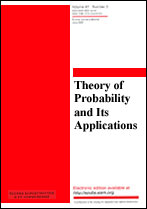|
|
Teoriya Veroyatnostei i ee Primeneniya, 1957, Volume 2, Issue 1, Pages 34–59
(Mi tvp4957)
|
 |
|
 |
This article is cited in 10 scientific papers (total in 10 papers)
On the Decomposition of the Convolution of Gaussian and Poissonian Laws
Yu. V. Linnik
Leningrad
Abstract:
The paper contains a detailed proof for the following theorem: the convolution of a Gaussian and a Poissonian law can be decomposed only into similar convolutions. More precisely, let $X=X_1+X_2$, where $X_1$ is a Gaussian component and $X_2$ a Poissonian component independent of $X_1$. If there is some other decomposition:
$X=Y_1+Y_2,Y_1$ being independent of $Y_2$, then
$$Y_1=Y_{11}+Y_{12},\\Y_2=Y_{21}+Y_{22}.$$
where
$Y_{11},Y_{21}$ are Gaussian and $Y_{12},Y_{22}$ Poissonian, all mutually independent, and
$$\mathbf D\left(Y_{11}\right)+\mathbf D\left(Y_{21}\right)=\mathbf D\left(X_1\right),\\\mathbf D\left(Y_{12}\right)+\mathbf D\left(Y_{22}\right)=\mathbf D\left(X_2\right).\\$$
Thus, H. Cramer's theorem on decomposing the normal law, and D. A. Raykov's theorem on decomposing the Poissonian law are special cases of this theorem.
Received: 19.11.1956
Citation:
Yu. V. Linnik, “On the Decomposition of the Convolution of Gaussian and Poissonian Laws”, Teor. Veroyatnost. i Primenen., 2:1 (1957), 34–59; Theory Probab. Appl., 2:1 (1957), 31–57
Linking options:
https://www.mathnet.ru/eng/tvp4957 https://www.mathnet.ru/eng/tvp/v2/i1/p34
|


| Statistics & downloads: |
| Abstract page: | 227 | | Full-text PDF : | 117 |
|




 Contact us:
Contact us: Terms of Use
Terms of Use
 Registration to the website
Registration to the website Logotypes
Logotypes








 Citation in format
Citation in format 
